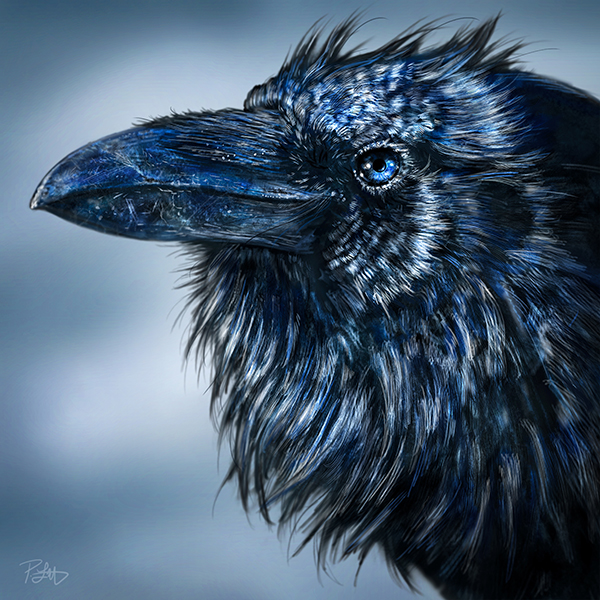
In the runup to the Banff Christmas Market, I had concerns. Will I have enough stock? Will I get enough sales? Will I get my editorial cartoons done each week? What if I get sick? What if the weather turns horrible?
Before I became a full-time artist in my early thirties, I worked several years in retail, tourism and office jobs. I ran a waterslide facility at a hotel in Banff for a few years. During the busy season, that place was always loud and full of people. I also managed a few retail stores in Banff for a while, so I’m no stranger to customer service work or crowded environments.
But I’ve been working at home by myself for nearly twenty years. These days, I thrive in quiet solitude. Though I’ve done the Calgary Expo every year for over a decade and the occasional holiday market around here, being ON in a public setting for a month required the reactivation of rusty skills.
In the four days between each market, I had to draw my daily editorial cartoons, update my bookkeeping, order stock, respond to client inquiries, and prepare for the following weekend. During a bit of a lull this past Saturday, I excitedly said to my market neighbours, “I get to paint next week!”
I haven’t had time to paint anything in over a month, and I’ve missed it.
It takes many hours to paint one of my animals. Sometimes, it doesn’t come together the way I want, and there’s no shortage of frustration. I wrote about that recently with the Ring-tailed Lemurs piece I’m working on. But creating the art is still the easy part. I want to problem-solve a painting, discover the solutions, and apply the lessons I learn from each piece to the next one.
However, the work surrounding the creative part takes more time than the art itself. When it’s your job, you can’t just create art; you must also sell it. Marketing and finding the products on which a particular art style works best is difficult. A product that sells well for one artist may not for another, and you only learn by trying.
My metal and canvas prints are higher-priced items that adorn the grid walls of my market booth, and those show off the brush strokes and colours better than any other substrate I sell. I don’t sell many of them because they have a higher price tag.
But they look amazing under lights, which attracts people to come into the booth in the first place. So, I need those higher-priced items to get people to stop and look at everything else. They’re products, but also advertising.
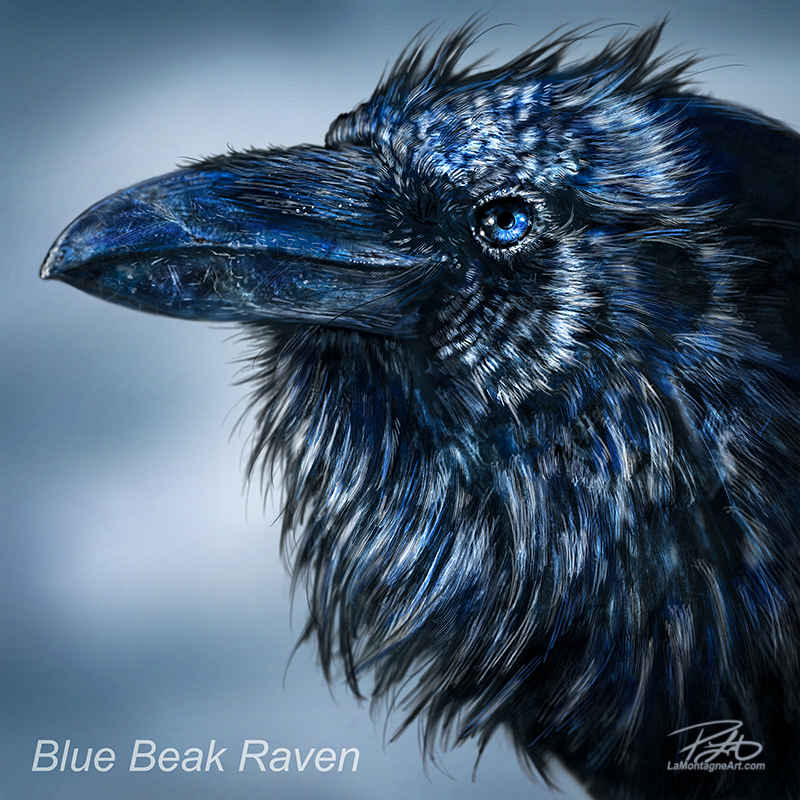 They do sell, however. I had one woman in Canmore send me an email after the market one Saturday night, regretting she didn’t buy the 16”X16” metal print of my Blue Beak Raven.
They do sell, however. I had one woman in Canmore send me an email after the market one Saturday night, regretting she didn’t buy the 16”X16” metal print of my Blue Beak Raven.
I told her I still had it; she sent me an e-transfer, and when I got to the show Sunday morning, I wrapped it and put it in my car. I delivered it to her the next day. Later that week, she sent me a photo of it hanging in her home. That never gets old.
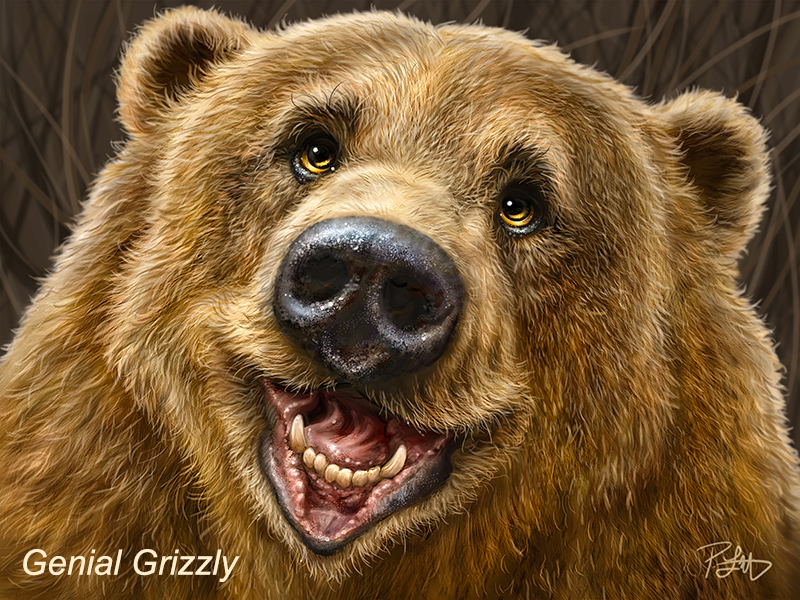 Another gentleman wanted the same size Spa Day painting on metal I had in the booth, plus a 12”X16” metal print of my Genial Grizzly I didn’t have. I said I could order and deliver the missing one to him, but he didn’t want to carry the other one around. He asked if he could pay for them, and I could order and drop both of them off in Canmore when they arrived. He wasn’t in a rush, and I was happy to accommodate.
Another gentleman wanted the same size Spa Day painting on metal I had in the booth, plus a 12”X16” metal print of my Genial Grizzly I didn’t have. I said I could order and deliver the missing one to him, but he didn’t want to carry the other one around. He asked if he could pay for them, and I could order and drop both of them off in Canmore when they arrived. He wasn’t in a rush, and I was happy to accommodate.
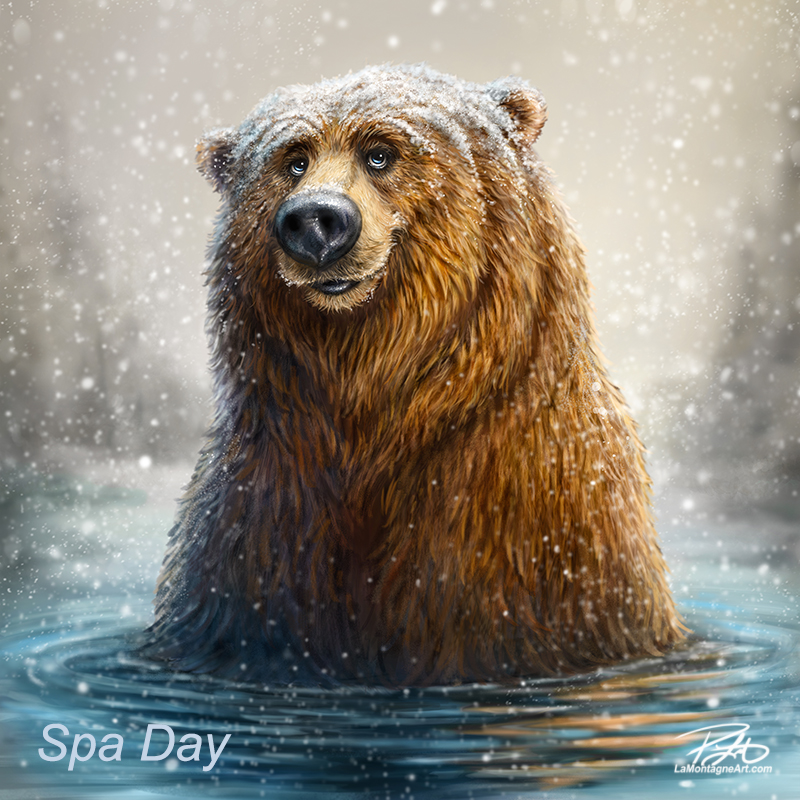 I wanted to sell the metal and canvas prints, but I didn’t want to lose Spa Day on the wall because it attracts a lot of attention. It has become a bestseller, and the metal prints on the wall sell the poster prints on the tables.
I wanted to sell the metal and canvas prints, but I didn’t want to lose Spa Day on the wall because it attracts a lot of attention. It has become a bestseller, and the metal prints on the wall sell the poster prints on the tables.
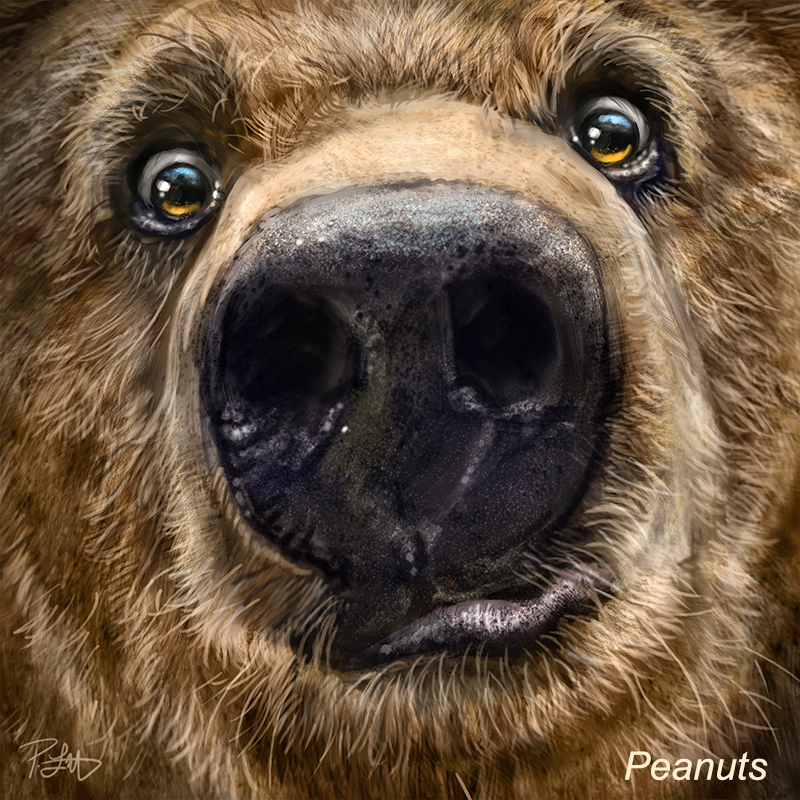 Prepare as I might; what’s true one day might not be the next. Last year, I had two metal prints of my Peanuts painting, one of my personal favourites. It doesn’t work as a poster print because it’s a square composition, so it’s only available in metal or canvas. This year, I made sure to have two metal prints on hand, and I sold them both the first weekend. So, I ordered three more for the last two weekends.
Prepare as I might; what’s true one day might not be the next. Last year, I had two metal prints of my Peanuts painting, one of my personal favourites. It doesn’t work as a poster print because it’s a square composition, so it’s only available in metal or canvas. This year, I made sure to have two metal prints on hand, and I sold them both the first weekend. So, I ordered three more for the last two weekends.
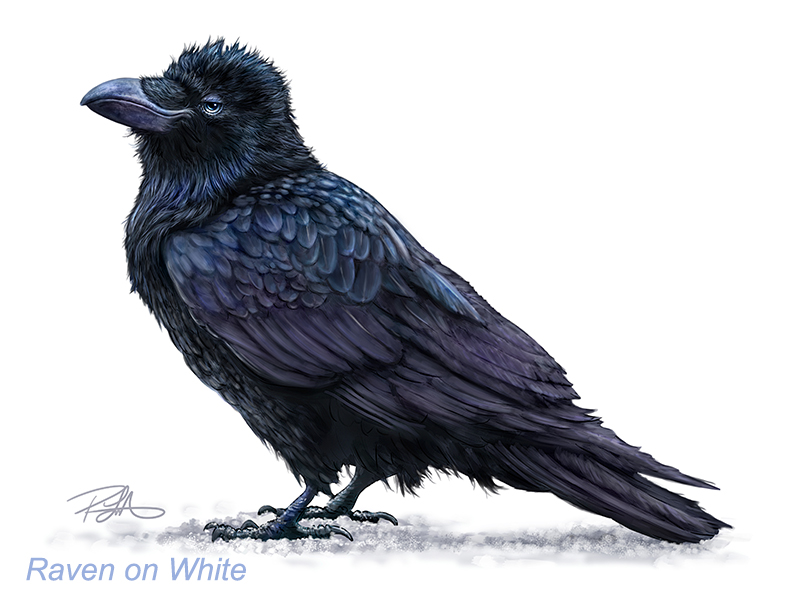 I had two metal prints of my Raven on White painting and two of my Highland Cows. I sold one of each the first weekend, so I figured I should get spares.
I had two metal prints of my Raven on White painting and two of my Highland Cows. I sold one of each the first weekend, so I figured I should get spares.
Those five metal prints arrived in time for the last two weekends, and I didn’t sell another of any of them. It turned out to be an unnecessary expense. There’s just no way to know.
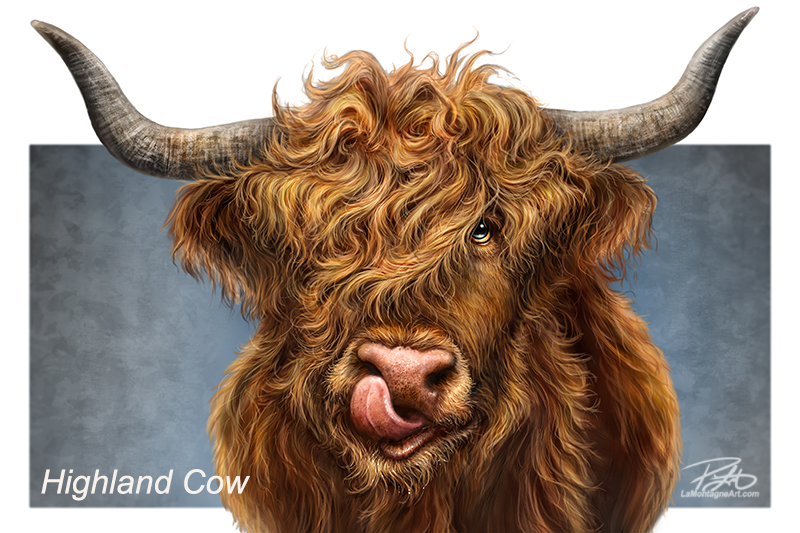 But the Highland Cow on the wall sold many poster prints over four weeks, more than any other image. The Raven on White print was also a bestseller.
But the Highland Cow on the wall sold many poster prints over four weeks, more than any other image. The Raven on White print was also a bestseller.
Thankfully, art doesn’t expire and those metal prints will sit safe and sound in their case until the Calgary Expo in the spring.
As for the other products, I sold a lot of small magnets and ceramic coasters. Those are Pacific Music & Art licensed products. Calendars sold well when I had them, but because the Canada Post strike is causing national shipping issues, I had none for the third weekend and couldn’t sell all the reorders the last weekend. As I write this post, there is no end in sight for the strike, so I have no idea when I’ll be able to sell my remaining stock. Unlike prints, calendars have a limited shelf life.
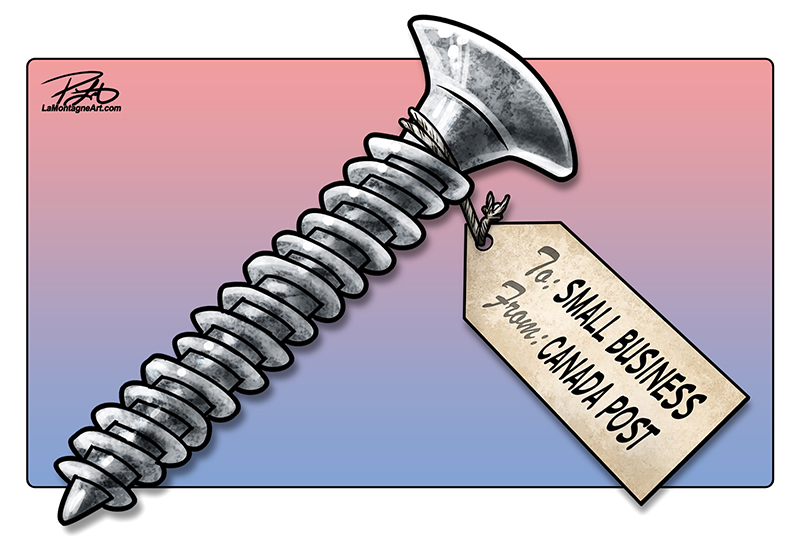
I’m very pleased and relieved that my large initial inventory of poster prints is now much smaller. Now that I have retired even more paintings, I’ll bring a leaner gallery of prints to the Expo in April, with many new paintings I’m working on and more popular and proven sellers than ever before.
What about my initial worries about four weeks of the Banff Christmas Market? For the most part, I had enough stock. When the Highland Cow prints sold out way too early, Art Ink Print in Victoria had my back and quickly resupplied me. Those continued to sell well the whole show. When I sold out of calendars and Highland Cow magnets, Pacific Music and Art did their best to deliver, though courier shipping delays threw a wrench in the gears, and those arrived later than I needed them.
As usual, I got my editorial cartoons done. Most of my newspaper clients don’t even know about this larger side of my business. Then again, many people who know my animal art don’t know about my editorial cartoons.
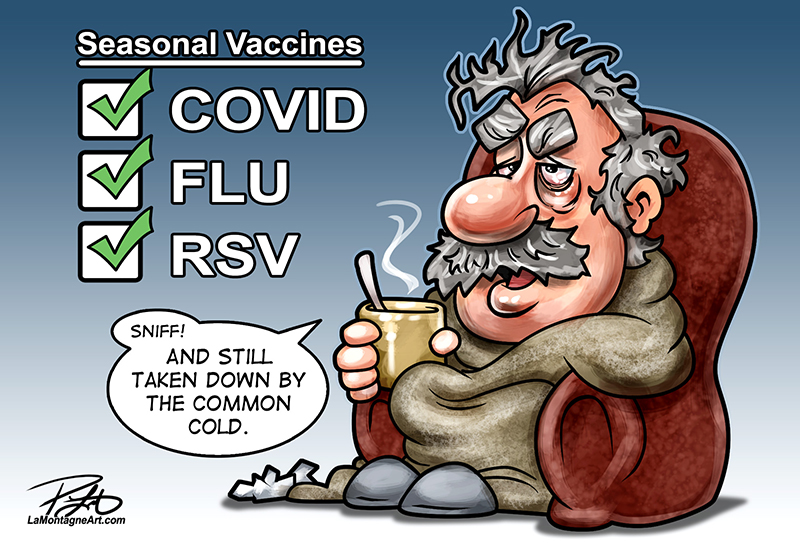 I had made sure to get my flu and COVID boosters before the markets, but still ‘got sick,’ knocked on my ass by a cold in between Weekends 2 and 3. If you wonder where I get my cartoon ideas, life inspires art. But just like everybody else who gambles with seasonal viruses, I handled it. Inconvenient, uncomfortable, but manageable. And though I began that third weekend still suffering and wearing a mask for a day, it was my second-best sales weekend.
I had made sure to get my flu and COVID boosters before the markets, but still ‘got sick,’ knocked on my ass by a cold in between Weekends 2 and 3. If you wonder where I get my cartoon ideas, life inspires art. But just like everybody else who gambles with seasonal viruses, I handled it. Inconvenient, uncomfortable, but manageable. And though I began that third weekend still suffering and wearing a mask for a day, it was my second-best sales weekend.
The weather was only horrible once when I had to drive home in a whiteout on frightening roads. There were a couple of icy mornings/evenings on the highway when a Chinook wind delivered rain around the freezing mark. But that’s just driving to work in Canada.
As for sales, I’m happy. The significant expense of booking the booth, insurance, ordering more stock than I’ve ever had, and gambling on such a large event paid off.
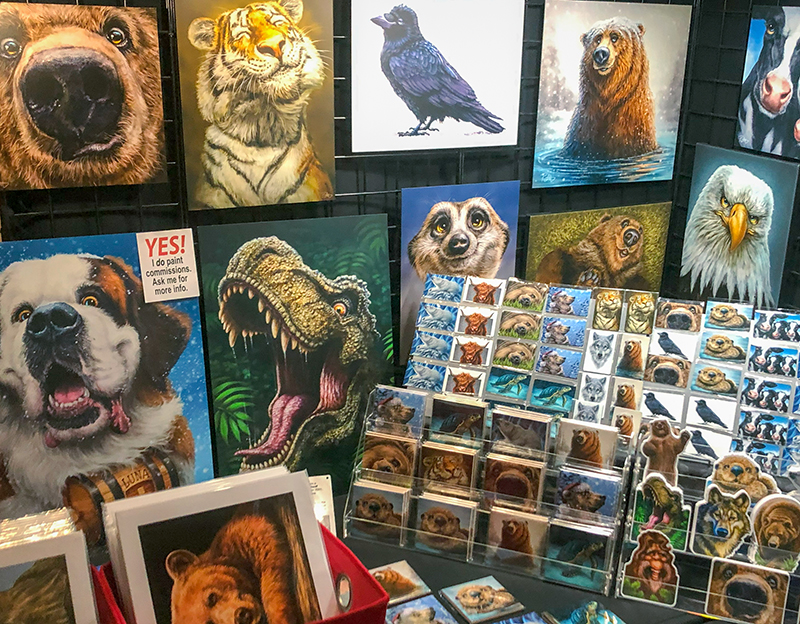 I regret I have no decent photos of my booth. The bright light on the artwork looks great in person, but my older iPhone camera just can’t seem to compensate correctly, even with an accessory filter. It’s no doubt a user problem.
I regret I have no decent photos of my booth. The bright light on the artwork looks great in person, but my older iPhone camera just can’t seem to compensate correctly, even with an accessory filter. It’s no doubt a user problem.
The new venue at The Banff Train Station was terrific. I was happy with the booth location and had a lot of fun with my neighbours. It was nice to have coworkers again, for a short time. While telling Shonna some of the funny stories, of which there were many, she laughed and said we sounded like a bunch of carnival workers.
She wasn’t wrong.
The organizers and staff put on a great show; I have no complaints or critiques. Challenges happen at every event, but this dedicated group handled them well, and I commend their efforts. Applications for Banff Christmas Market 2025 aren’t until February, but I’m ready to do this again next year for all four weeks if they’ll have me.
Finally, thanks to all of you who came to see me at my booth. Some subscribers even drove out from Canmore, Calgary, or other parts of Alberta because they had read my posts about the market. It was great to see you, and I’ll see several of you again in April at the Expo.
I added a lot of new subscribers to A Wilder View and hope you new people enjoy following my art and the stories behind it. Thanks for taking some of my work home with you or buying it for gifts. Each year, more people tell me they have one or more of my funny-looking animal paintings. They’ve bought them at The Calgary Zoo, Discovery Wildlife Park, or in one of the many retail stores in Canada selling products made by my licensing clients.
Many have bought the art directly from me at the Calgary Expo or previous Christmas markets. You all say the nicest things and pay me the kindest compliments. I’m never comfortable with that, but I’ve learned long ago just to say Thank You.
Face-to-face time with people who enjoy my work never fails to refill the creative tank. I can’t tell you how fulfilling it is to see my silly little critters make people smile or to hear how happy they make you.
So far this week, I’ve been busy drawing cartoons, doing the bookkeeping, organizing my booth hardware and products and putting it all away for a few months. I’m tired and ready for a break, looking forward to quiet time alone, with tunes in the earbuds, fresh hot coffee, and uninterrupted hours painting little hairs on smiling faces.
Art-for-a-living is a lot of work, but your support makes it well worth it. Thank you.
Cheers,
Patrick
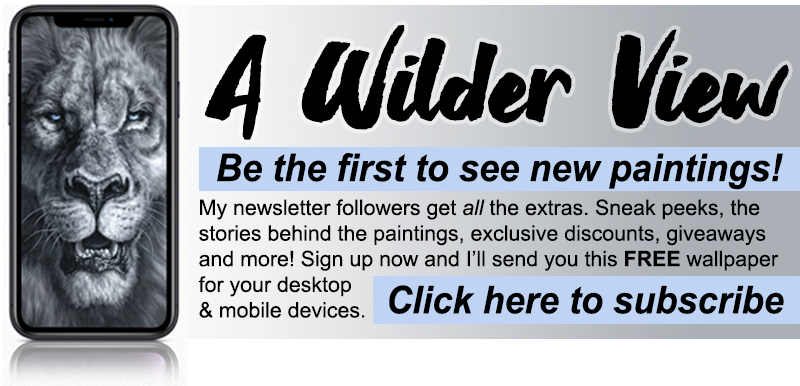
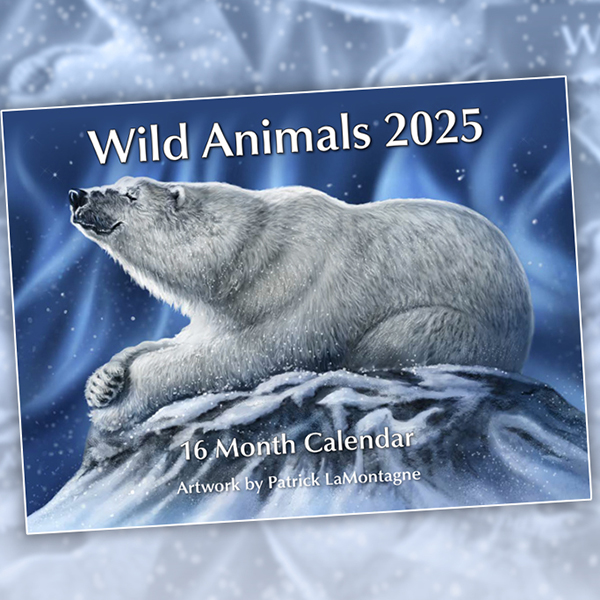
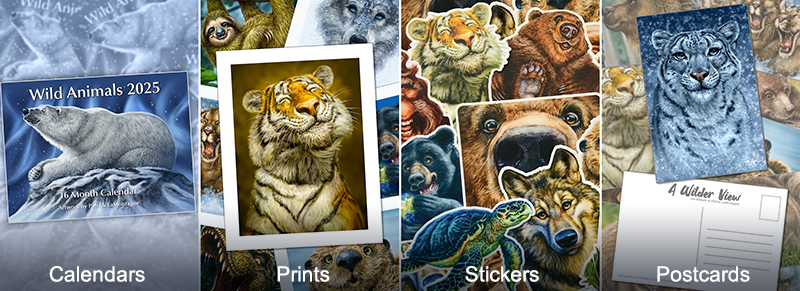
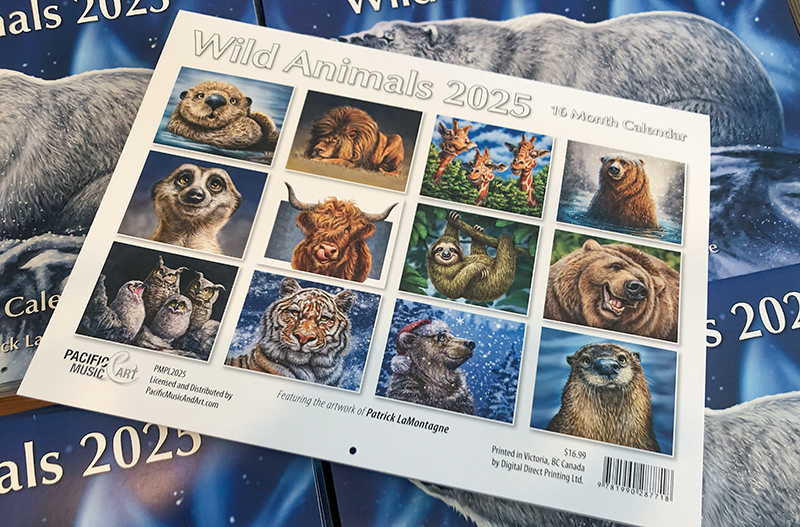 I still have plenty of 2025 calendars available, plus various prints, postcard sets and large vinyl stickers in my regular stock. So, if you’re still looking for your 2025 calendar full of funny-looking animals and don’t need it shipped for Christmas, you may place your orders.
I still have plenty of 2025 calendars available, plus various prints, postcard sets and large vinyl stickers in my regular stock. So, if you’re still looking for your 2025 calendar full of funny-looking animals and don’t need it shipped for Christmas, you may place your orders.
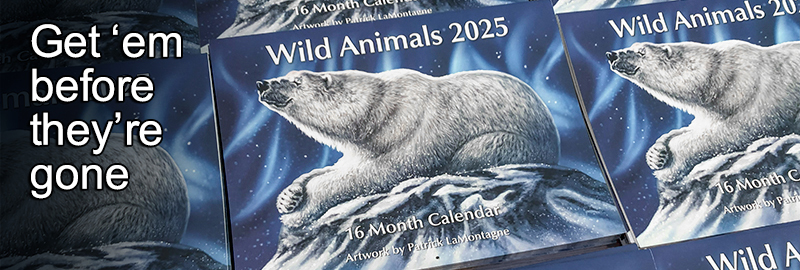

 They do sell, however. I had one woman in Canmore send me an email after the market one Saturday night, regretting she didn’t buy the 16”X16” metal print of my Blue Beak Raven.
They do sell, however. I had one woman in Canmore send me an email after the market one Saturday night, regretting she didn’t buy the 16”X16” metal print of my Blue Beak Raven. Another gentleman wanted the same size Spa Day painting on metal I had in the booth, plus a 12”X16” metal print of my Genial Grizzly I didn’t have. I said I could order and deliver the missing one to him, but he didn’t want to carry the other one around. He asked if he could pay for them, and I could order and drop both of them off in Canmore when they arrived. He wasn’t in a rush, and I was happy to accommodate.
Another gentleman wanted the same size Spa Day painting on metal I had in the booth, plus a 12”X16” metal print of my Genial Grizzly I didn’t have. I said I could order and deliver the missing one to him, but he didn’t want to carry the other one around. He asked if he could pay for them, and I could order and drop both of them off in Canmore when they arrived. He wasn’t in a rush, and I was happy to accommodate. I wanted to sell the metal and canvas prints, but I didn’t want to lose Spa Day on the wall because it attracts a lot of attention. It has become a bestseller, and the metal prints on the wall sell the poster prints on the tables.
I wanted to sell the metal and canvas prints, but I didn’t want to lose Spa Day on the wall because it attracts a lot of attention. It has become a bestseller, and the metal prints on the wall sell the poster prints on the tables. Prepare as I might; what’s true one day might not be the next. Last year, I had two metal prints of my Peanuts painting, one of my personal favourites. It doesn’t work as a poster print because it’s a square composition, so it’s only available in metal or canvas. This year, I made sure to have two metal prints on hand, and I sold them both the first weekend. So, I ordered three more for the last two weekends.
Prepare as I might; what’s true one day might not be the next. Last year, I had two metal prints of my Peanuts painting, one of my personal favourites. It doesn’t work as a poster print because it’s a square composition, so it’s only available in metal or canvas. This year, I made sure to have two metal prints on hand, and I sold them both the first weekend. So, I ordered three more for the last two weekends. I had two metal prints of my Raven on White painting and two of my Highland Cows. I sold one of each the first weekend, so I figured I should get spares.
I had two metal prints of my Raven on White painting and two of my Highland Cows. I sold one of each the first weekend, so I figured I should get spares. But the Highland Cow on the wall sold many poster prints over four weeks, more than any other image. The Raven on White print was also a bestseller.
But the Highland Cow on the wall sold many poster prints over four weeks, more than any other image. The Raven on White print was also a bestseller.
 I had made sure to get my flu and COVID boosters before the markets, but still ‘got sick,’ knocked on my ass by a cold in between Weekends 2 and 3. If you wonder where I get my cartoon ideas, life inspires art. But just like everybody else who gambles with seasonal viruses, I handled it. Inconvenient, uncomfortable, but manageable. And though I began that third weekend still suffering and wearing a mask for a day, it was my second-best sales weekend.
I had made sure to get my flu and COVID boosters before the markets, but still ‘got sick,’ knocked on my ass by a cold in between Weekends 2 and 3. If you wonder where I get my cartoon ideas, life inspires art. But just like everybody else who gambles with seasonal viruses, I handled it. Inconvenient, uncomfortable, but manageable. And though I began that third weekend still suffering and wearing a mask for a day, it was my second-best sales weekend. I regret I have no decent photos of my booth. The bright light on the artwork looks great in person, but my older iPhone camera just can’t seem to compensate correctly, even with an accessory filter. It’s no doubt a user problem.
I regret I have no decent photos of my booth. The bright light on the artwork looks great in person, but my older iPhone camera just can’t seem to compensate correctly, even with an accessory filter. It’s no doubt a user problem.
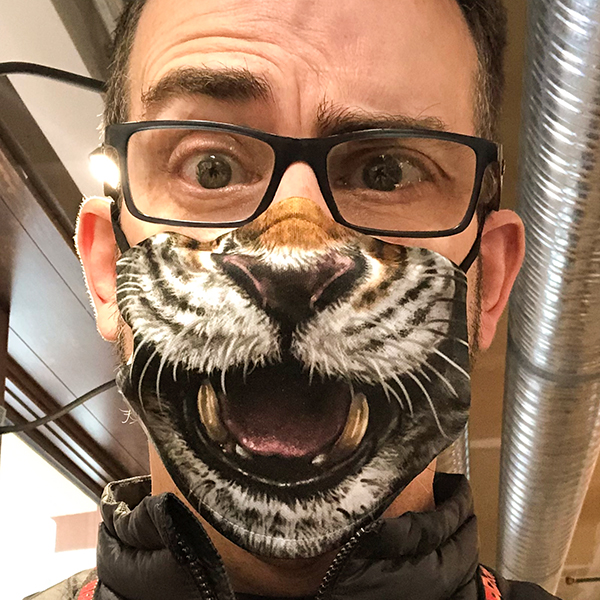
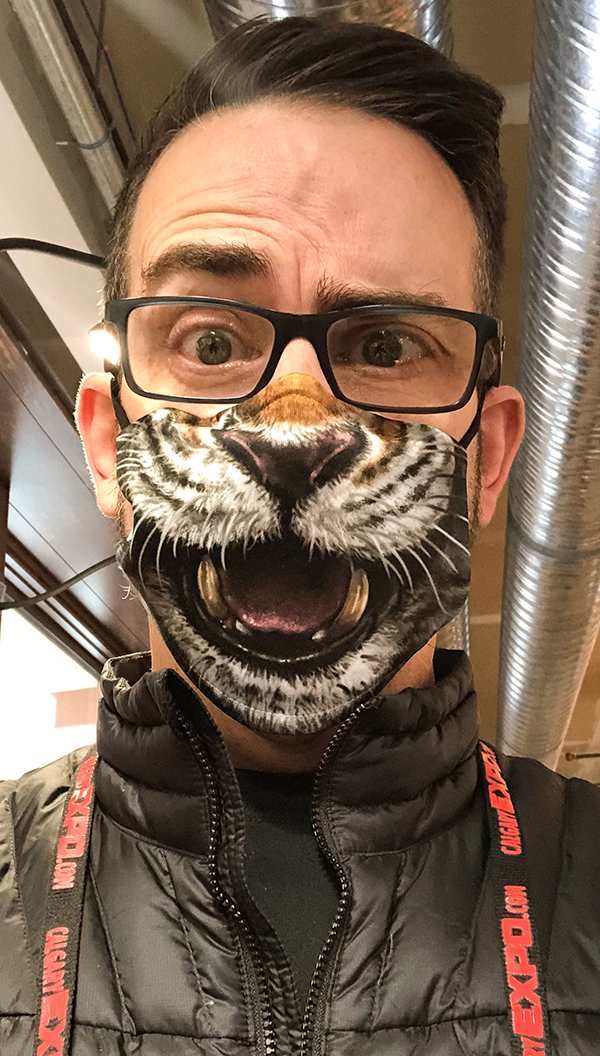 Last week was a challenge.
Last week was a challenge.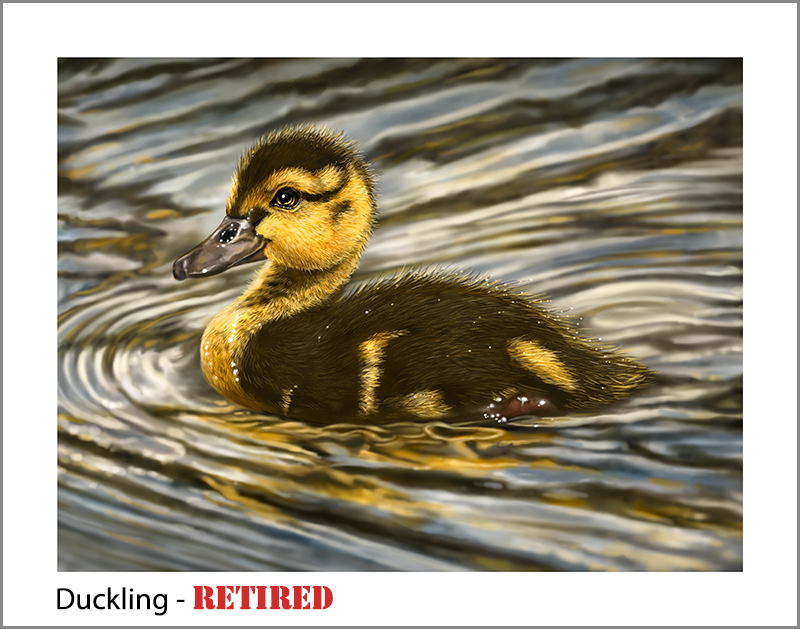 I never know which paintings will become popular and which ones won’t resonate with people. Or sometimes people will like an image, just not as a print to hang on their wall. The only way to find out is to create the painting, release it, and see what happens. When I retire an image in print, it means it will no longer be available on my site or at markets.
I never know which paintings will become popular and which ones won’t resonate with people. Or sometimes people will like an image, just not as a print to hang on their wall. The only way to find out is to create the painting, release it, and see what happens. When I retire an image in print, it means it will no longer be available on my site or at markets.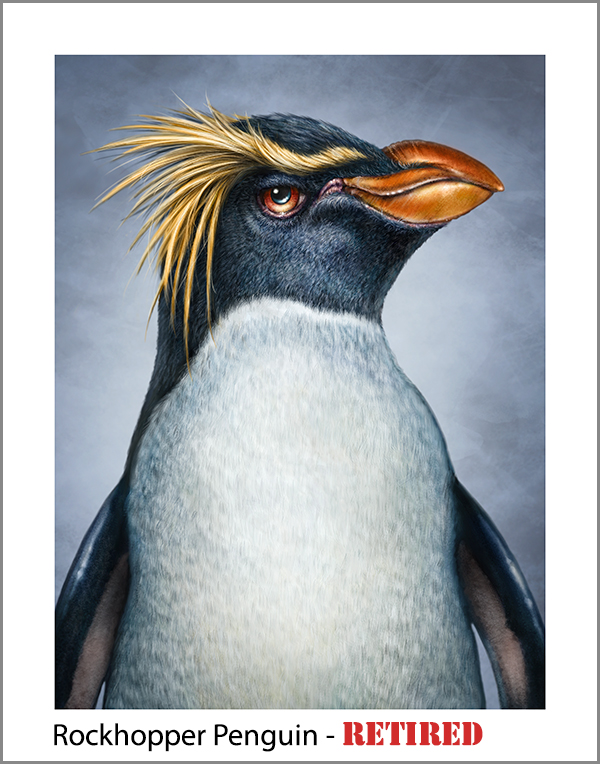 Sometimes, a print will become popular for a particular venue, like the
Sometimes, a print will become popular for a particular venue, like the 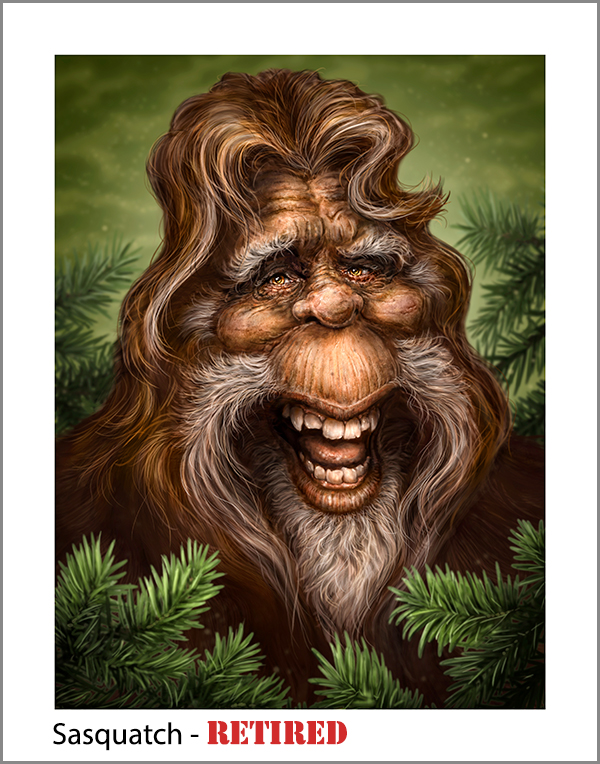 My Sasquatch painting is a popular licensed image for Pacific Music & Art, as they have customers all over the Pacific Northwest, BC, and Alaska.
My Sasquatch painting is a popular licensed image for Pacific Music & Art, as they have customers all over the Pacific Northwest, BC, and Alaska. 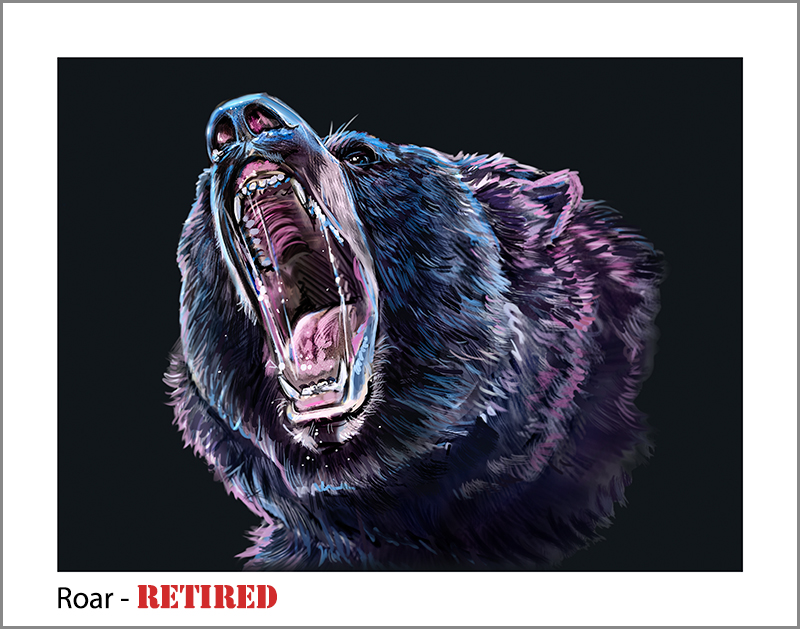
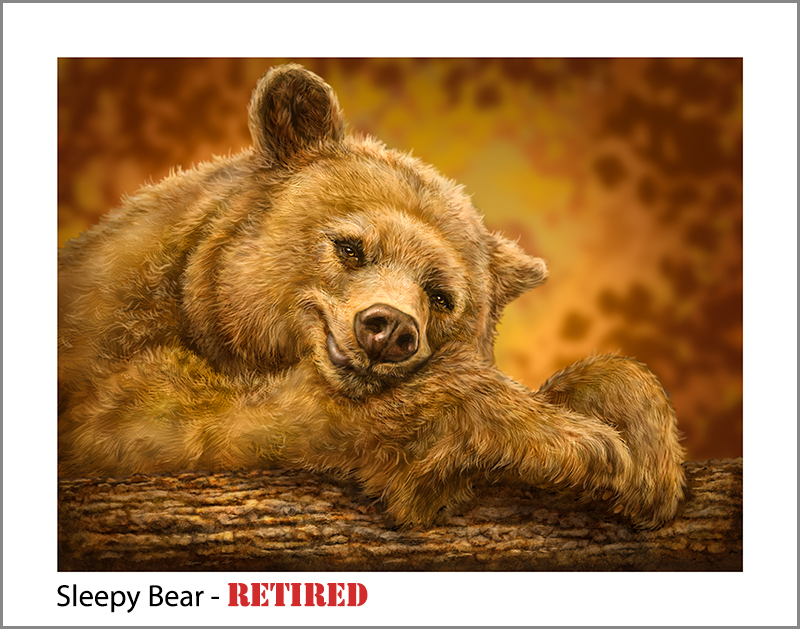
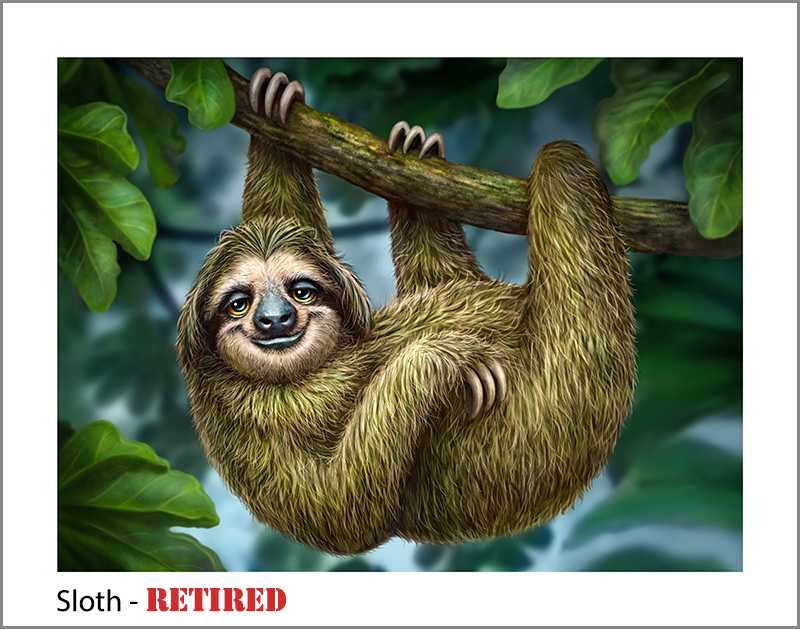 Even when I no longer sell a print, my licensing clients may still offer the image on their products, and my wholesale customers may still order prints from me to sell to their customers. I just have to require the same minimum orders from them that my printer requires from me.
Even when I no longer sell a print, my licensing clients may still offer the image on their products, and my wholesale customers may still order prints from me to sell to their customers. I just have to require the same minimum orders from them that my printer requires from me.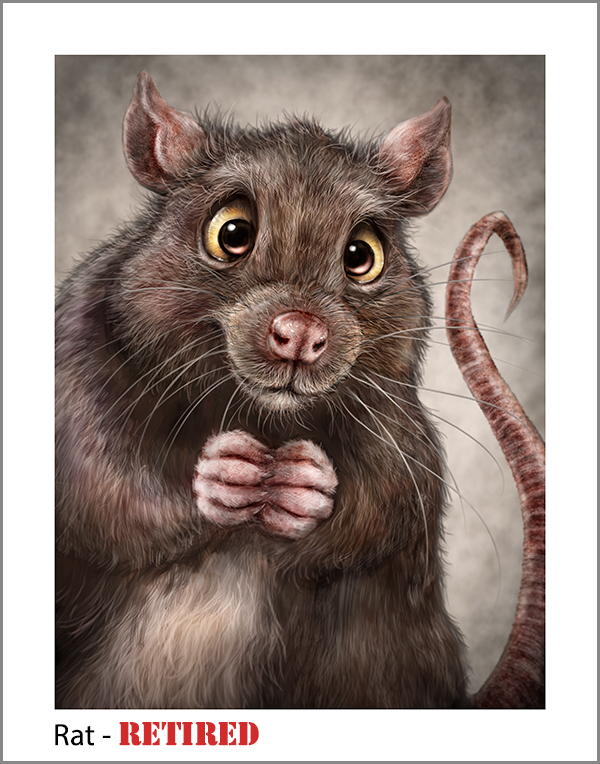 My next-door neighbours,
My next-door neighbours, 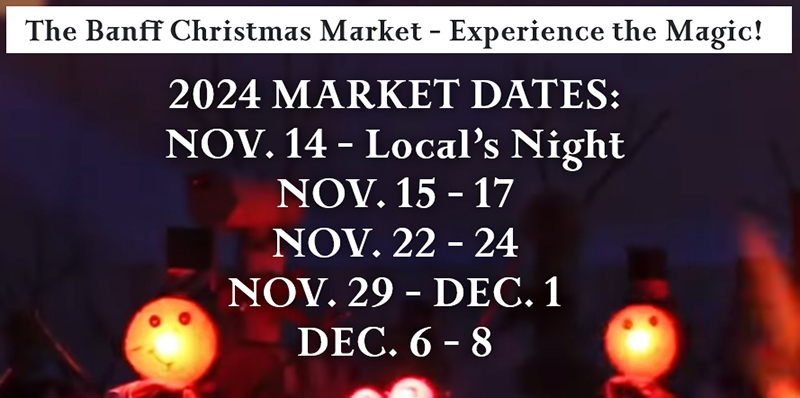
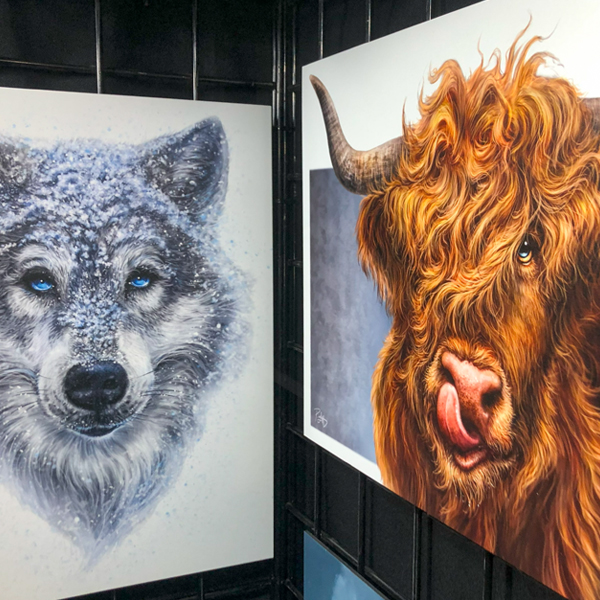
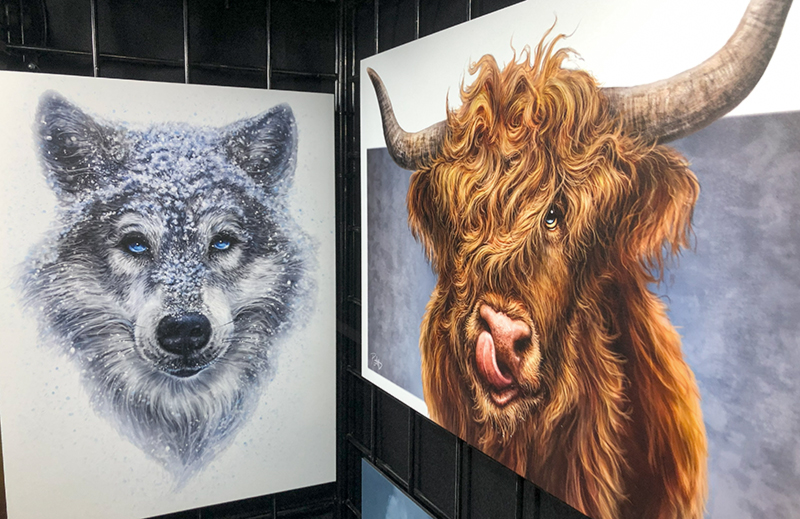 The weather outside was frightful last Friday and Saturday, but the Bow Valley avoided the worst of the big storm that rolled through Alberta on the weekend. Still, I have lived in this valley long enough to know that the 25 km stretch of highway between Canmore and Banff can quickly become treacherous.
The weather outside was frightful last Friday and Saturday, but the Bow Valley avoided the worst of the big storm that rolled through Alberta on the weekend. Still, I have lived in this valley long enough to know that the 25 km stretch of highway between Canmore and Banff can quickly become treacherous.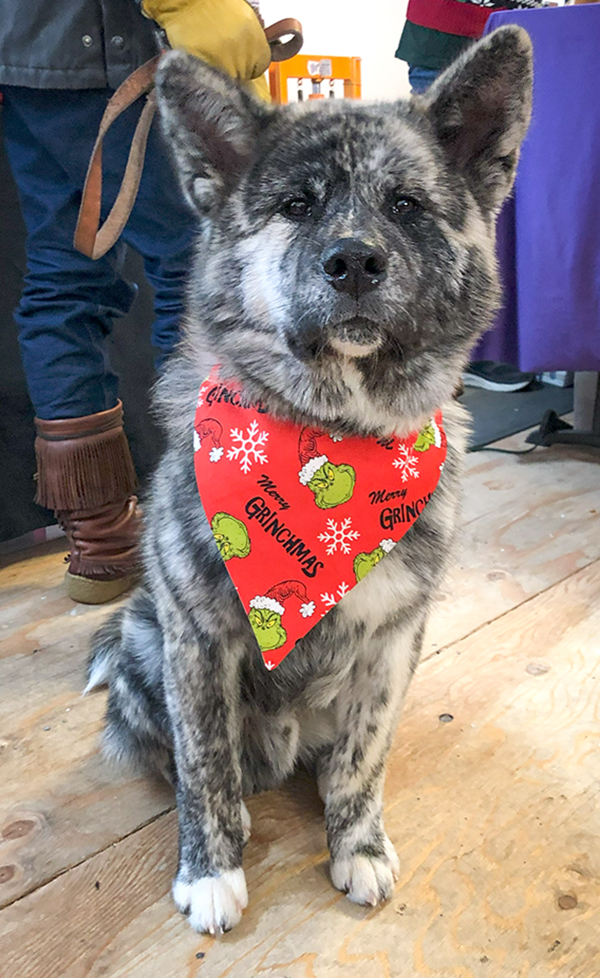 One of the dogs I get to see all month long is Tojo, who belongs to one of the staff. He’s a friendly Akita puppy with a stunning brindle fur pattern resembling urban camouflage. He’s got a wonderfully sweet temperament and loves the outdoor cold. Though provided with a comfortable bed and a safe, warm space outside, you can often find him happily sleeping on a pile of snow.
One of the dogs I get to see all month long is Tojo, who belongs to one of the staff. He’s a friendly Akita puppy with a stunning brindle fur pattern resembling urban camouflage. He’s got a wonderfully sweet temperament and loves the outdoor cold. Though provided with a comfortable bed and a safe, warm space outside, you can often find him happily sleeping on a pile of snow.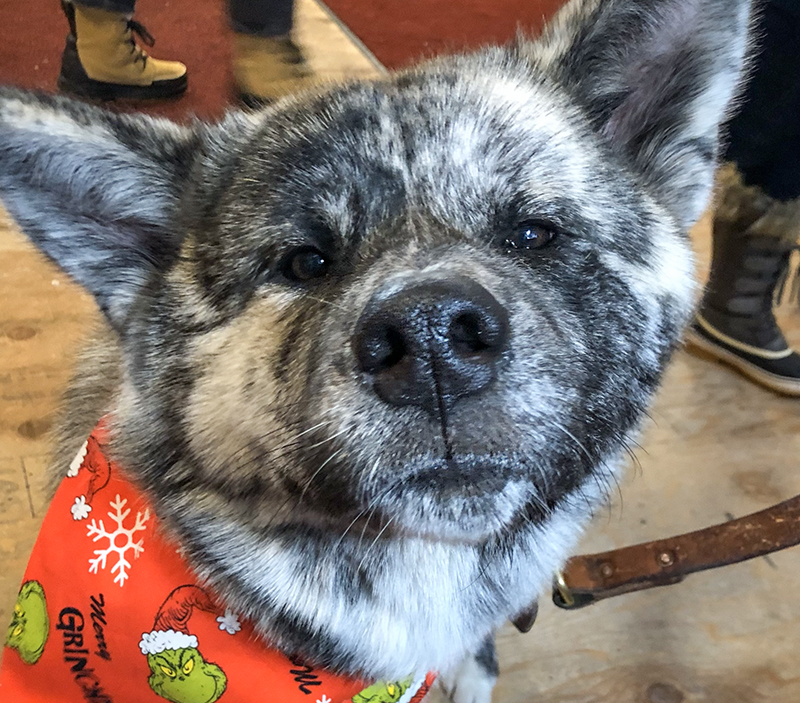 When he’s brought inside to warm up or for a wander, he visits the different booths and enjoys the pets and scratches we’re all happy to give. His face reminds me of a bear’s, which makes me want to paint him.
When he’s brought inside to warm up or for a wander, he visits the different booths and enjoys the pets and scratches we’re all happy to give. His face reminds me of a bear’s, which makes me want to paint him.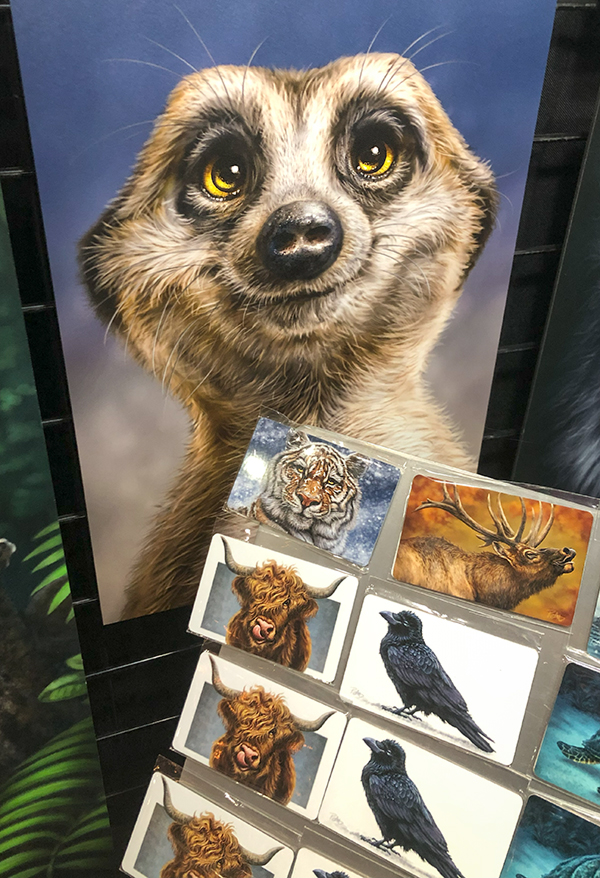 Seriously, what is it with this painting? I don’t understand it, but as I said to Mike at Pacific, I won’t look a gift cow in the mouth.
Seriously, what is it with this painting? I don’t understand it, but as I said to Mike at Pacific, I won’t look a gift cow in the mouth.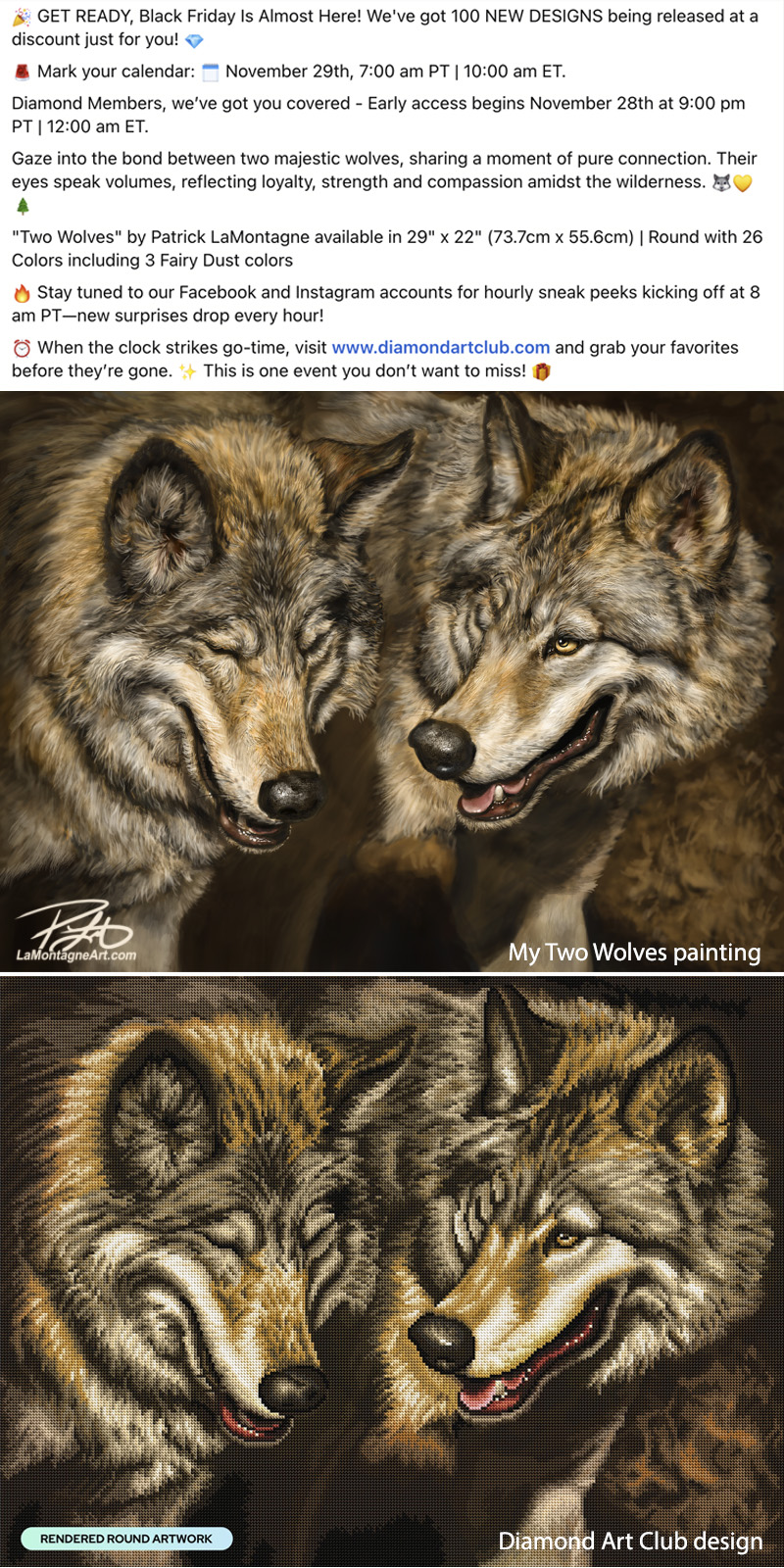
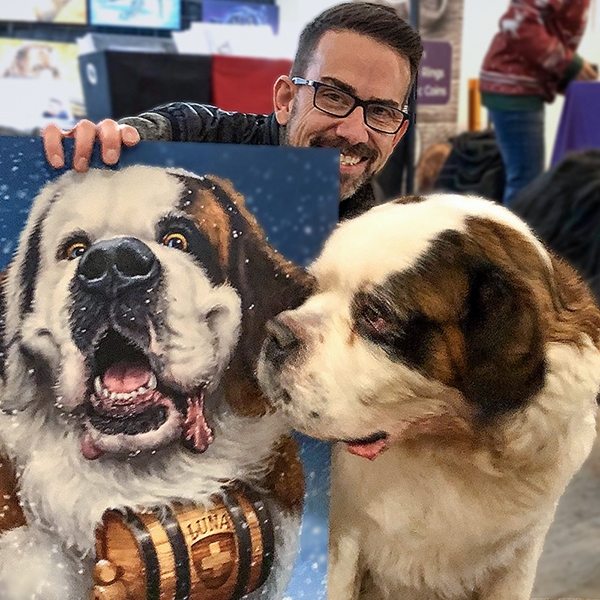
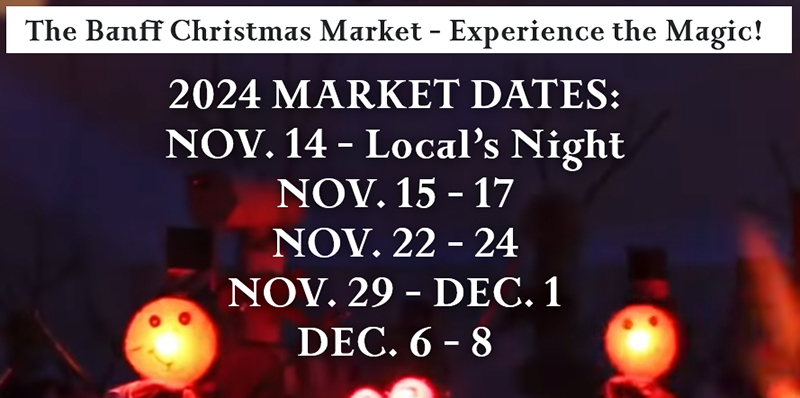

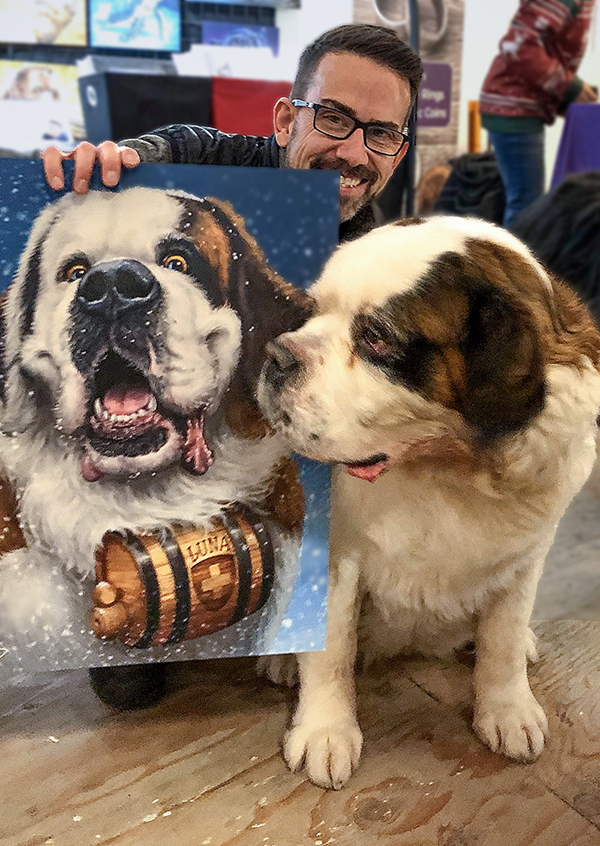
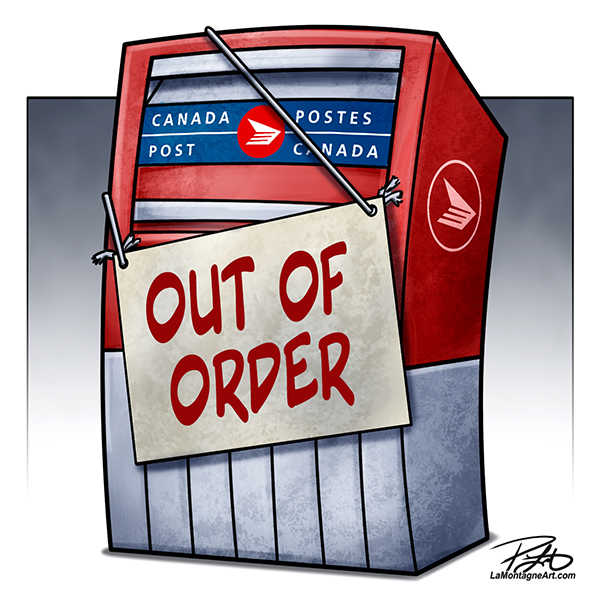
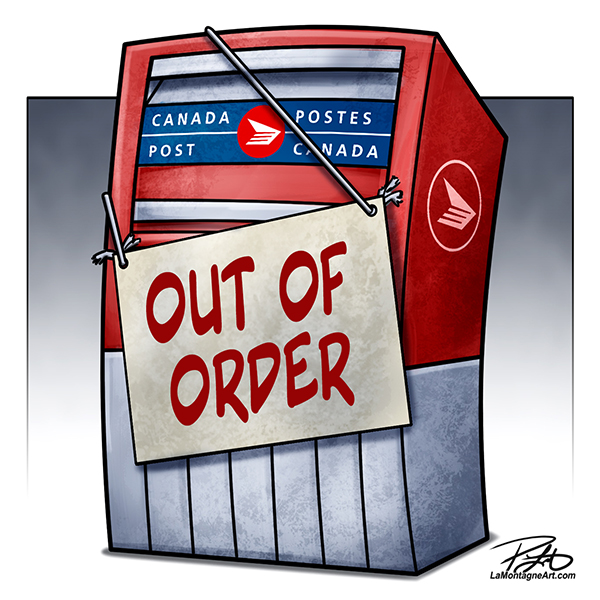

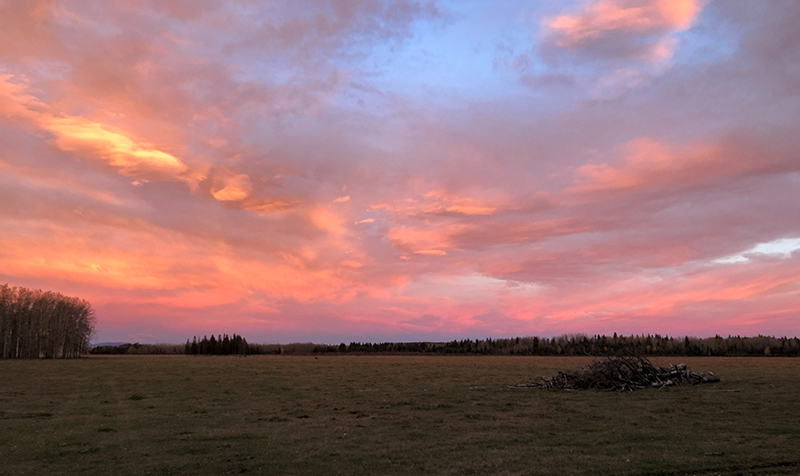 With a lot to do and feeling like I was way behind, a cabin trip seemed like a low priority. But it’s an inexpensive getaway, a relatively short drive, and I needed a break.
With a lot to do and feeling like I was way behind, a cabin trip seemed like a low priority. But it’s an inexpensive getaway, a relatively short drive, and I needed a break.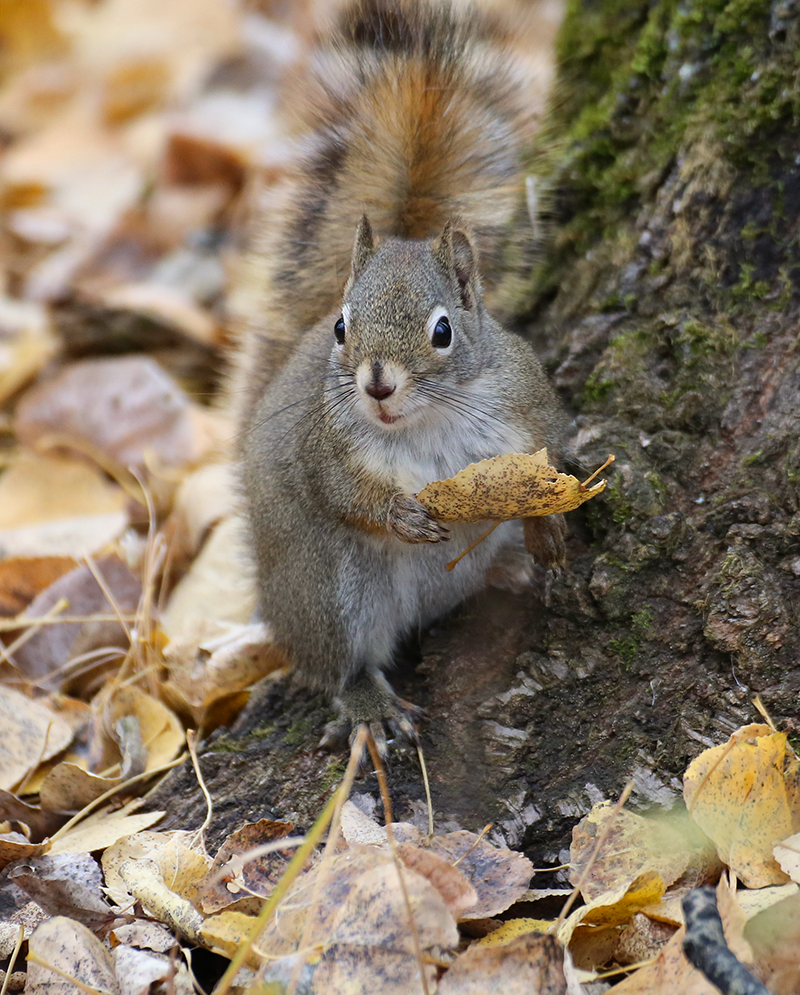 Not the most exciting critter encounters, but I got some good squirrel pics. This amusing little chatterbox might very well inspire a painting.
Not the most exciting critter encounters, but I got some good squirrel pics. This amusing little chatterbox might very well inspire a painting.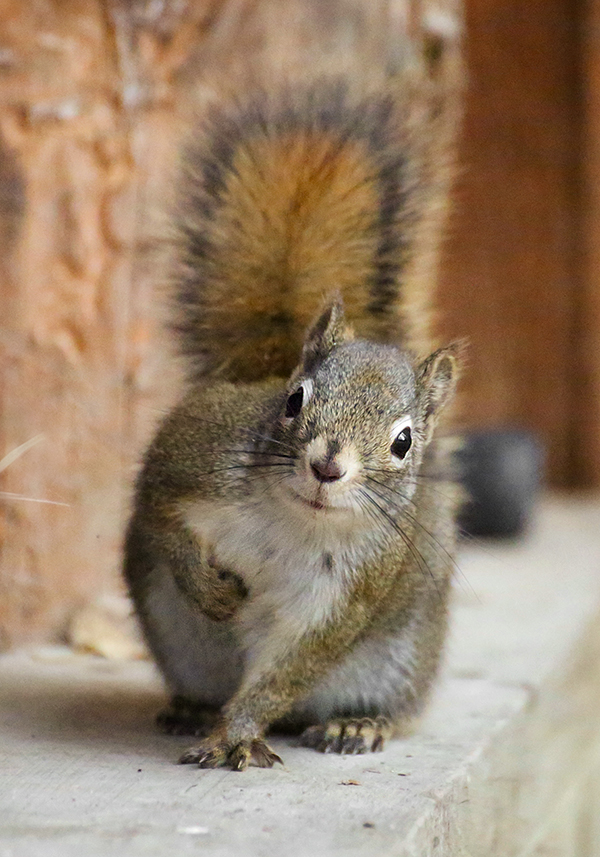 I took photos of wind-broken tree stumps where I might place an owl or eagle. A natural doorway created by curved and fallen branches has potential. You never know what might spark a new piece.
I took photos of wind-broken tree stumps where I might place an owl or eagle. A natural doorway created by curved and fallen branches has potential. You never know what might spark a new piece.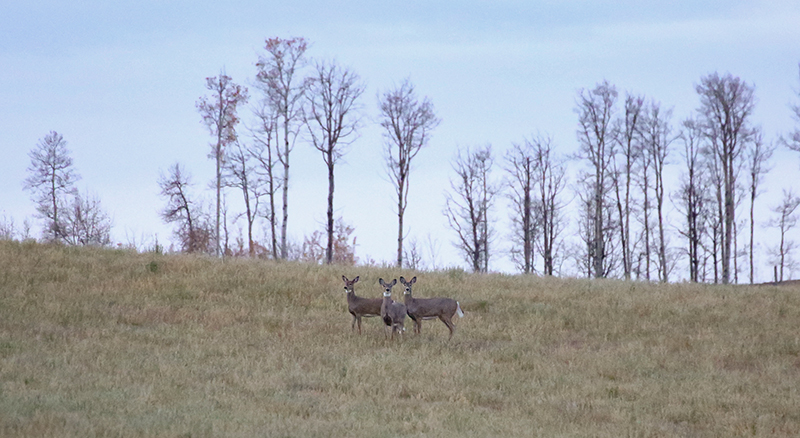 Though we had visited with them earlier, the owners texted us Sunday evening that the Atlas comet was barely visible over the pasture. It had been brighter and more evident days earlier, but this was the last chance to see it. We walked out in the dark, not wanting to use flashlights that might ruin our night vision and found the faint anomaly among the sea of stars. Darrel took this shot on his newer phone. I couldn’t get a good capture with mine. You can just see the comet tail on the left.
Though we had visited with them earlier, the owners texted us Sunday evening that the Atlas comet was barely visible over the pasture. It had been brighter and more evident days earlier, but this was the last chance to see it. We walked out in the dark, not wanting to use flashlights that might ruin our night vision and found the faint anomaly among the sea of stars. Darrel took this shot on his newer phone. I couldn’t get a good capture with mine. You can just see the comet tail on the left.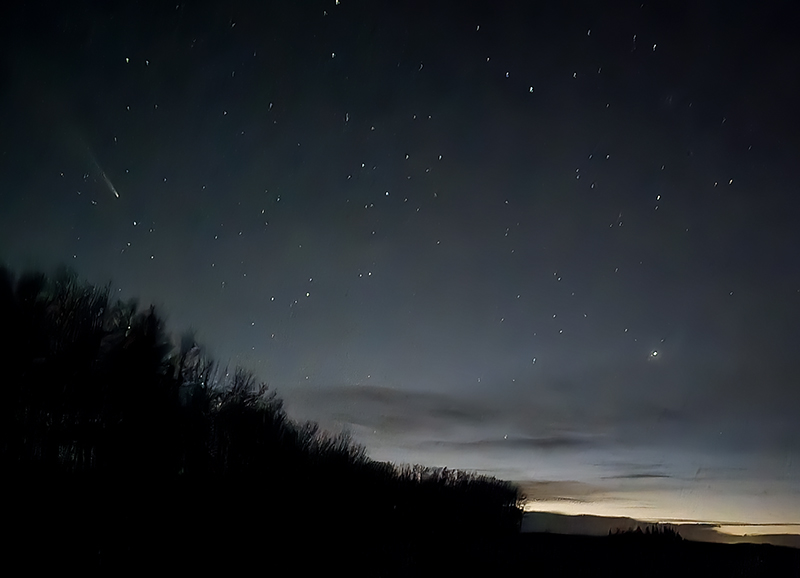 We had nice fall weather for most of our time there, but it got cold and windy Sunday night and Monday. A snowstorm hit Calgary and Canmore, and given the road reports and Shonna’s texts, I was thrilled I didn’t have to drive back until Tuesday.
We had nice fall weather for most of our time there, but it got cold and windy Sunday night and Monday. A snowstorm hit Calgary and Canmore, and given the road reports and Shonna’s texts, I was thrilled I didn’t have to drive back until Tuesday.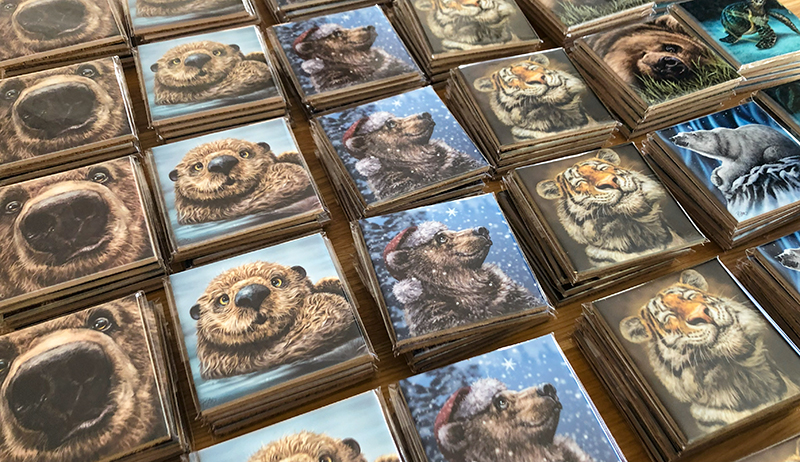 My order from Pacific Music & Art was waiting for me when I got home, and it contained
My order from Pacific Music & Art was waiting for me when I got home, and it contained 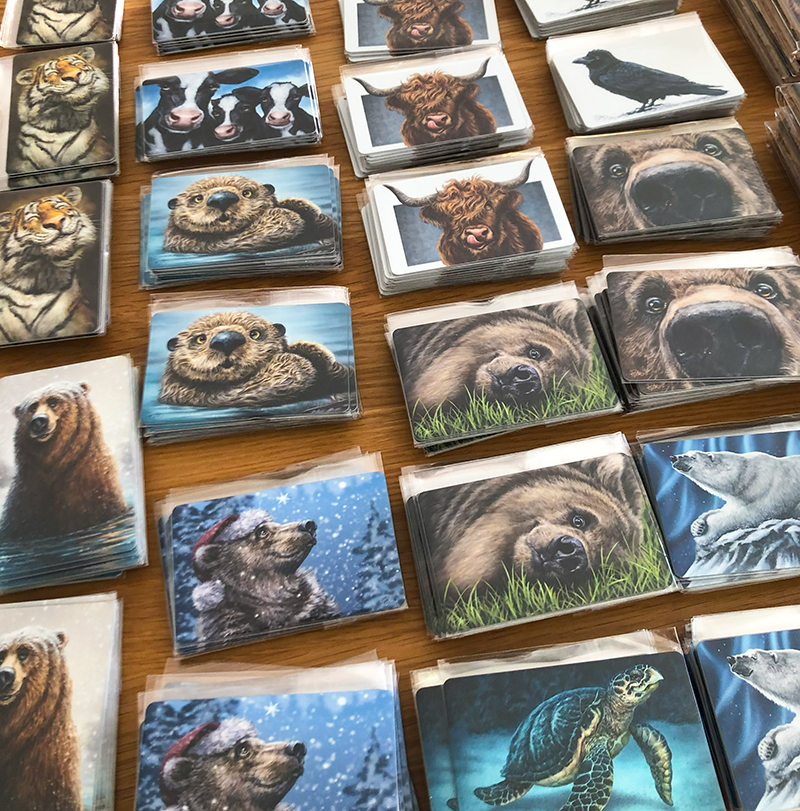 On the one hand, it shows that this side of my business continues to grow. As it’s the work I enjoy most and has the best chance of ensuring my financial future, I’m grateful. But it’s a significant investment of time and money that comes with no small amount of anxiety.
On the one hand, it shows that this side of my business continues to grow. As it’s the work I enjoy most and has the best chance of ensuring my financial future, I’m grateful. But it’s a significant investment of time and money that comes with no small amount of anxiety.
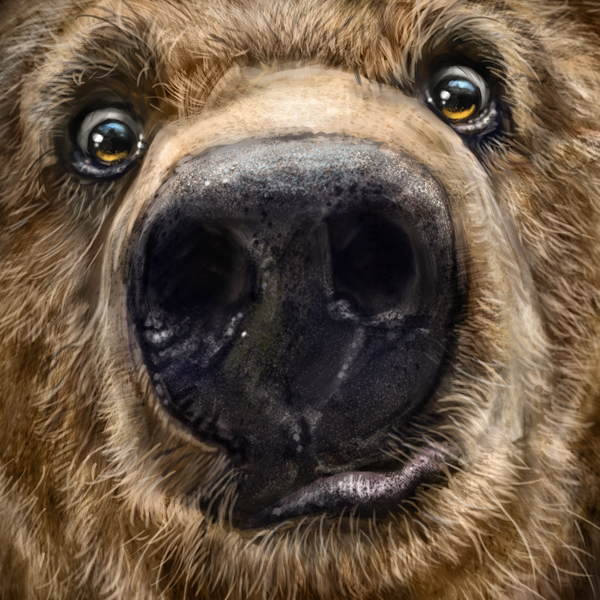
 With a website and
With a website and 
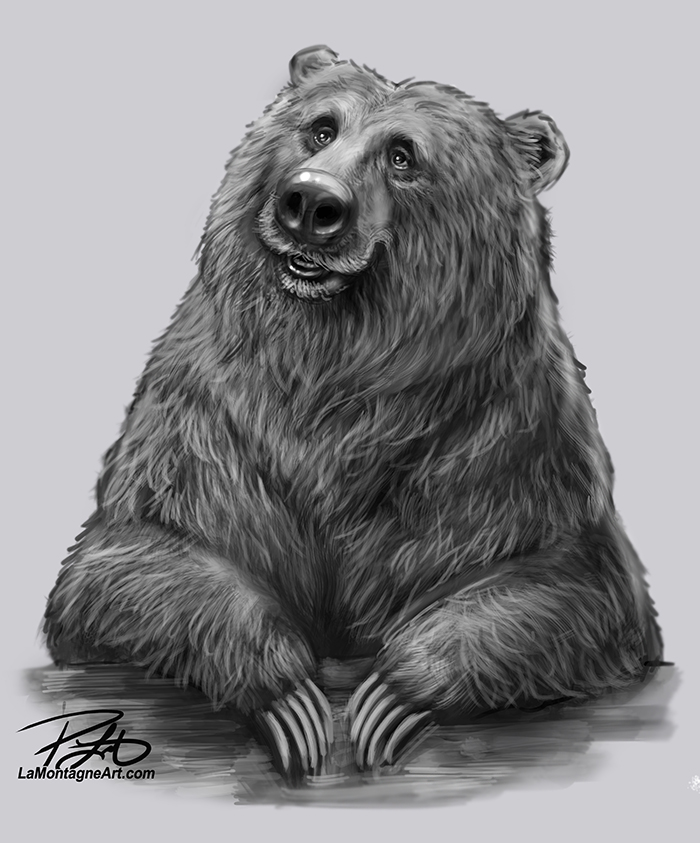 Over the past week, I’ve received a few
Over the past week, I’ve received a few 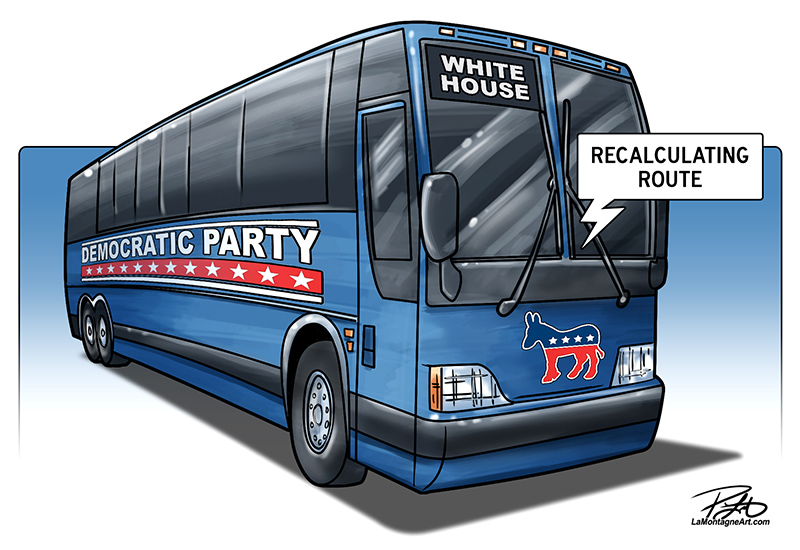 This past Sunday, I had drawn two cartoons in the morning and was going to paint all afternoon. Then President Biden announced he was no longer running for re-election, and suddenly, I had to draw a new cartoon for Monday morning. While drawing each cartoon takes a few hours or more, I first have to come up with the idea, which also takes time.
This past Sunday, I had drawn two cartoons in the morning and was going to paint all afternoon. Then President Biden announced he was no longer running for re-election, and suddenly, I had to draw a new cartoon for Monday morning. While drawing each cartoon takes a few hours or more, I first have to come up with the idea, which also takes time.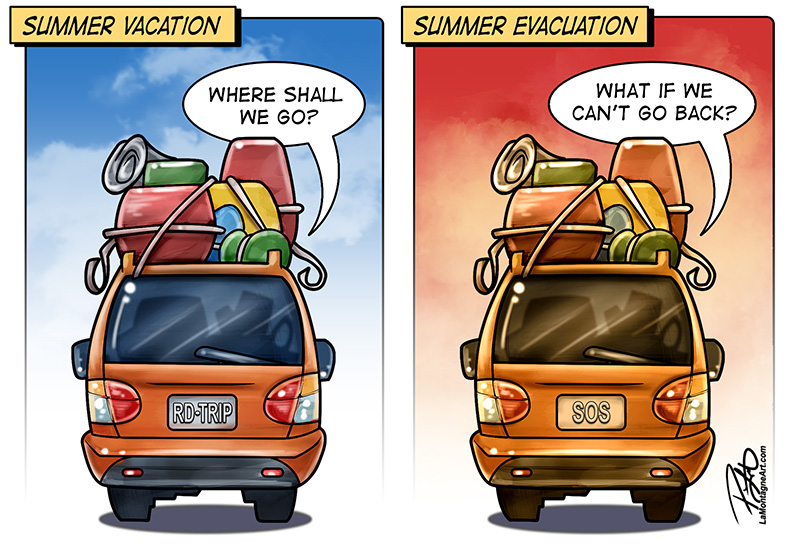 Adjusting course, I planned to paint all day Tuesday but woke to find out that the town of Jasper had evacuated for a wildfire. Suddenly, I had to scrap the cartoon I’d already drawn and sent Monday afternoon for the
Adjusting course, I planned to paint all day Tuesday but woke to find out that the town of Jasper had evacuated for a wildfire. Suddenly, I had to scrap the cartoon I’d already drawn and sent Monday afternoon for the 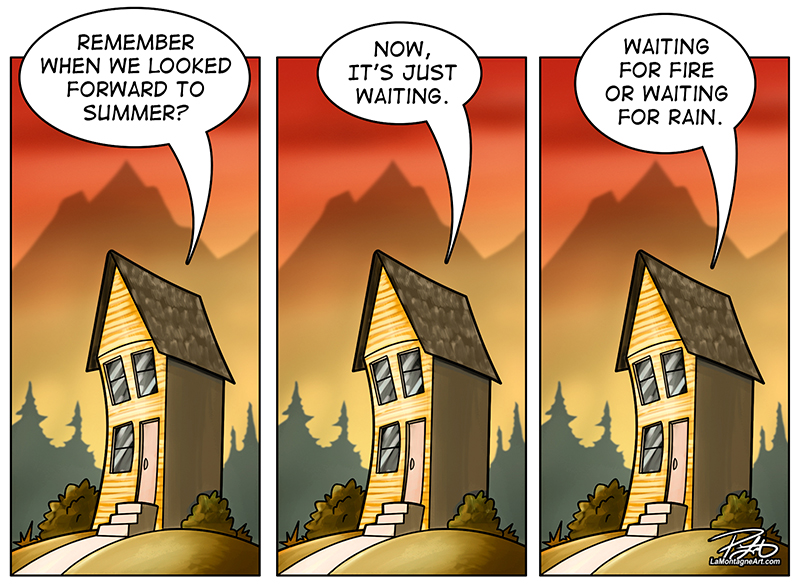 Having been through an evacuation in 2013 (water, not fire), and the odds are a little too good we may one day go through that again; I feel for those people. It’s a frightening thing to leave your home and not know if will be there when you get back. As the fire has breached the town of Jasper, and structures are burning, some people will lose everything. What makes it worse is when insensitive, small-minded keyboard warriors post stupid things like, “It’s only stuff.”
Having been through an evacuation in 2013 (water, not fire), and the odds are a little too good we may one day go through that again; I feel for those people. It’s a frightening thing to leave your home and not know if will be there when you get back. As the fire has breached the town of Jasper, and structures are burning, some people will lose everything. What makes it worse is when insensitive, small-minded keyboard warriors post stupid things like, “It’s only stuff.”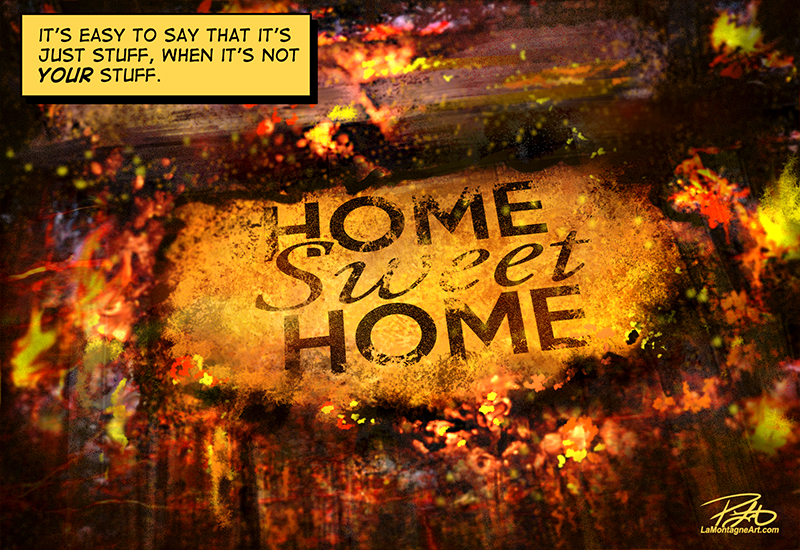 I have several paintings in progress, a few I expected to be done by now, which is frustrating. Because each features several animals, they take much longer, contributing to the feeling I’m not producing enough finished work.
I have several paintings in progress, a few I expected to be done by now, which is frustrating. Because each features several animals, they take much longer, contributing to the feeling I’m not producing enough finished work.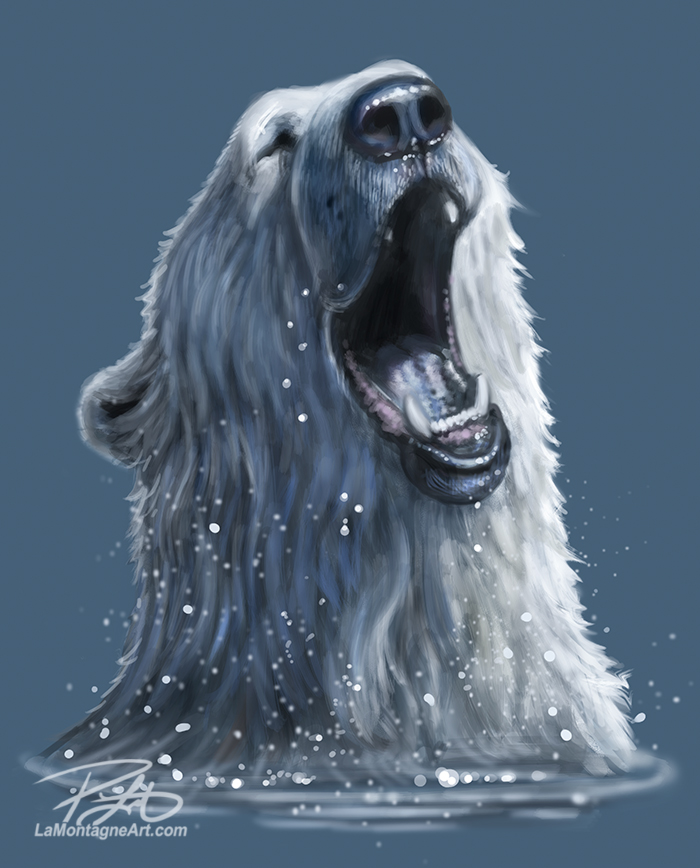 In the meantime, I hope you’re having a good summer despite the oppressive heat and wildfire smoke in some places. After a cool and comfortable rainy June, our July has sucked up all the moisture, and our brown grass and crispy trees could use some precipitation.
In the meantime, I hope you’re having a good summer despite the oppressive heat and wildfire smoke in some places. After a cool and comfortable rainy June, our July has sucked up all the moisture, and our brown grass and crispy trees could use some precipitation.
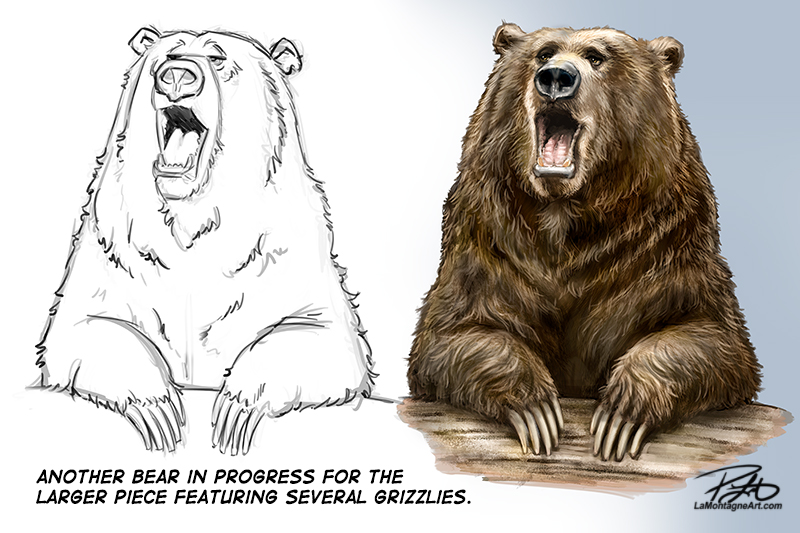 The paintings I was already working on need to be done by the end of next month so I can order puzzles and products for the markets. Then there are the sketches, paintings and writing for the book, six editorial
The paintings I was already working on need to be done by the end of next month so I can order puzzles and products for the markets. Then there are the sketches, paintings and writing for the book, six editorial 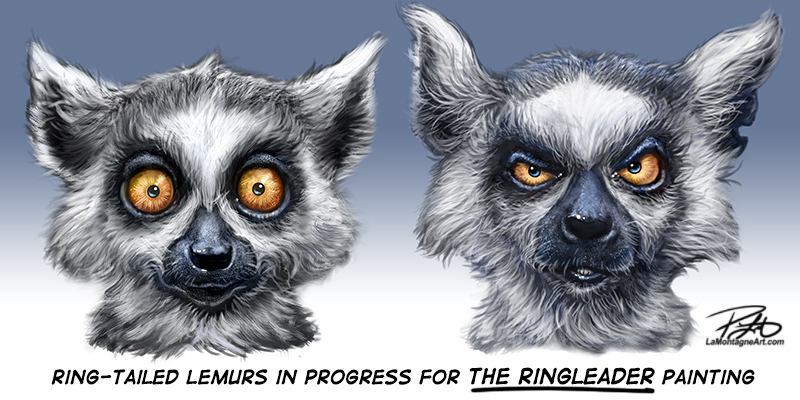 Sure, I’ll bitch about being too busy sometimes, but I chose this. Though the landscape will change, as will the work, and it’s unlikely ever to get easier, I plan to create art as long as possible. I don’t know if I could do anything else, now.
Sure, I’ll bitch about being too busy sometimes, but I chose this. Though the landscape will change, as will the work, and it’s unlikely ever to get easier, I plan to create art as long as possible. I don’t know if I could do anything else, now.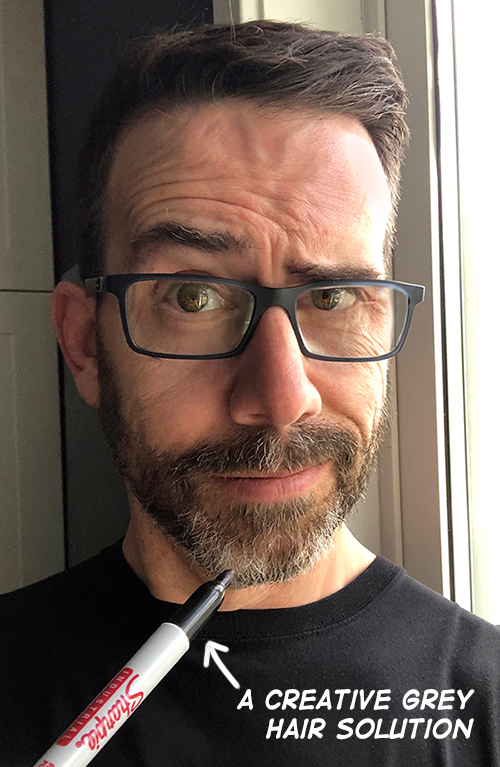 I’m grateful for so many of you who follow my work, comment on my posts or write emails, sending me wildlife pictures and thoughts about something I’ve shared or the artwork in general. With so much content available to us, that anyone volunteers to receive my
I’m grateful for so many of you who follow my work, comment on my posts or write emails, sending me wildlife pictures and thoughts about something I’ve shared or the artwork in general. With so much content available to us, that anyone volunteers to receive my